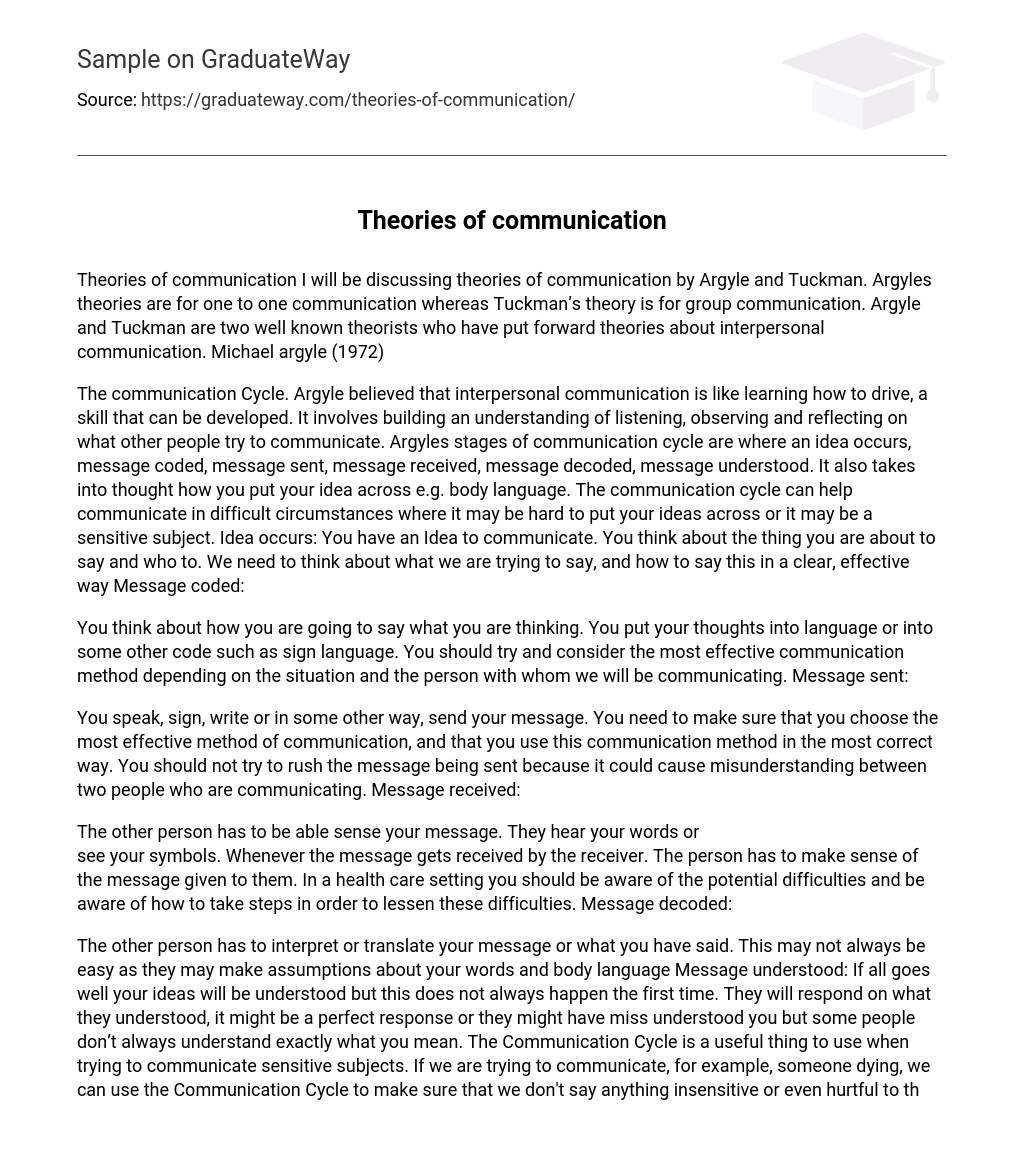Argyles theories are for one to one communication whereas Tuckman’s theory is for group communication. Argyle and Tuckman are two well known theorists who have put forward theories about interpersonal communication.
Michael Argyle (1972)
Argyle believed that interpersonal communication is like learning how to drive, a skill that can be developed. It involves building an understanding of listening, observing and reflecting on what other people try to communicate. Argyles stages of communication cycle are where an idea occurs, message coded, message sent, message received, message decoded, message understood. It also takes into thought how you put your idea across e.g. body language. The communication cycle can help communicate in difficult circumstances where it may be hard to put your ideas across or it may be a sensitive subject.
Message coded
You think about how you are going to say what you are thinking. You put your thoughts into language or into some other code such as sign language. You should try and consider the most effective communication method depending on the situation and the person with whom we will be communicating.
Message sent
You speak, sign, write or in some other way, send your message. You need to make sure that you choose the most effective method of communication, and that you use this communication method in the most correct way. You should not try to rush the message being sent because it could cause misunderstanding between two people who are communicating.
Message received
The other person has to be able sense your message. They hear your words or see your symbols. Whenever the message gets received by the receiver. The person has to make sense of the message given to them. In a health care setting you should be aware of the potential difficulties and be aware of how to take steps in order to lessen these difficulties.
Message decoded
The other person has to interpret or translate your message or what you have said. This may not always be easy as they may make assumptions about your words and body language.
Message understood
If all goes well your ideas will be understood but this does not always happen the first time. They will respond on what they understood, it might be a perfect response or they might have miss understood you but some people don’t always understand exactly what you mean.
The Communication Cycle is a useful thing to use when trying to communicate sensitive subjects. If we are trying to communicate, for example, someone dying, we can use the Communication Cycle to make sure that we don’t say anything insensitive or even hurtful to the person who is meant to be receiving the information,
Bruce Tuckman (1965)
Tuckman thought that the communication within a group can be effected by how the people should feel around each other and if these people have first met different people may have different reactions. Tuckman’s theory stages can help a group reach effective communication more quickly; with more understanding .Tuckman suggested four stages to a process groups go through.
Forming
A group of strangers come together for a meeting and begin to talk about themselves .This stage is important because group members get to know each other and become friendly. At first group members tend to behave independently and although goodwill exists they do not know each other well enough to unconditionally trust one another. Also the behaviour of each individual is driven by a desire to be accepted by others in the group. Conflict and controversial topics are avoided and group members focus on the task at hand. Individuals are also gathering information and impressions about each other. Although this is a comfortable stage to be in, the avoidance of conflict means not a lot of work gets done.
Storming
This is when the group begin to fall out with certain people and there is tension within the group and disagreement about how the group acts. In this stage important issues start to be addressed. Some people’s patience will break early and minor confrontations arise that are quickly dealt with. This is important for the growth of the group. This stage distinguishes the strong groups from the weaker ones as some group do not make it past this stage. Relationships between group members will be made or broken at this stage and some will never recover. It is important for the group to have a strong leadership at this stage.
Norming
At this stage the team agree on rules and values by which they will work. The group begin to trust themselves and individuals start to take greater responsibility so the leader can take a step back. This is also when things composed within the group and they find themselves coming to an agreement and meet each other halfway and they can work effectively and comfortably. Also After the arguments, they now have a better understanding of each other and are more able to appreciate each other’s skills and experience. They will listen, appreciate, and support each other. However, individuals have to work hard to keep this stage.
Performing
Not all groups reach this stage as its characterised by a state of interpendence and flexibility. Everyone is task-orientated, and this high degree of comfort means that all the energy of the group can be directed towards the task in hand and they can completes tasks more quickly and efficiently. Decision making is collaborative and there will be high level of respect in the group for each other.
Adjourning
Tuckman added this stage after 10 years. This stage is about completion and disengagement, both from the tasks and the group members. Individuals will be proud of having achieved much and glad to have been part such a successful it also means breaking up the team.





